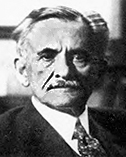
 Albert Abraham Michelson
Albert Abraham Michelson
1923-1927 NAS President
As mentioned, Charles Walcott stepped down just as the Academy was beginning to occupy its new quarters and Albert Michelson (1852–1931) took his place. Michelson had been born in what is now Poland, but his parents had decided to come to the United States when he was still a child. They settled in California and Nevada where his father had considerable success while serving as one of the purveyors to the mines in the area.
Young Albert had his basic education in the schools of San Francisco. On reaching college age in 1869 he decided that he would like to go to the Naval Academy as an appointee from the state of Nevada where the family was based at the time. The story goes that three competitors for the position became involved in a tie and it was not clear what would happen next. Apparently young Michelson went to Washington on one of the newly operating transcontinental trains and made an appointment to see President Grant. The latter listened to his tale and liked what he heard. As a result, the President settled the issue in favor of his visitor. Michelson did well at the Naval Academy and became a teacher there. Along the way, he managed to spend a period working in Helmholtz's laboratory in Berlin where he became deeply involved in the frontiers of European science and honed his talents.
Soon thereafter he left the navy and took a position (1881) at what was then the Case School of Applied Science in Cleveland. There he began to carry out the experiments upon which much of his great fame rests. Using ingeniously designed optical equipment, he attempted to measure the velocity of light relative to the presumably static ether as the earth rounded its course. The most revealing experiments of the time were carried out in 1886 with Professor Edward W. Morley (1838–1923), a colleague. The more carefully they made the measurements, however, the less evidence they found for anything resembling a stationary ether. The velocity of light as measured in the laboratory appeared to remain constant for all directions of the earth's motion. This result caused much controversy, but was finally resolved when Einstein proposed the special theory of relativity as a result of his very acute insight, linked with the fact that Maxwell's equations are invariant under the Lorentz Transformation. Initially, the transformation was regarded to be no more than a mathematical device that H. A. Lorentz had introduced as a useful helpmate in solving some problems in electromagnetic theory.
The best evidence seems to suggest that Einstein was not actually aware of the Michelson-Morley experiments at the time he proposed the special theory of relativity. Apparently, even in his precocious teenage years, he had concluded intuitively that the speed of light was probably invariant in any uniformly moving frame of reference.
Edward Morley
It should be added that Morley's previous career had not been in physics but in chemistry, with astronomy as a principal side interest. He was well known for precision measurements of atomic weights and of very small variations in the oxygen/nitrogen ratio of the atmosphere under varying conditions of weather. His initial involvement with Michelson came about through the fact that his laboratory was found to be the best place on campus to carry out the experiment. Moreover, Michelson was pleased to have the cooperation of such a good scientist. In 1898 Morley repeated the experiment with Dayton C. Miller, a colleague. The results were the same within experimental error. Morley was a central figure of attention when he attended the Congress of Physics in Paris in 1900 where Lord Kelvin questioned him closely.
From Case, Michelson went to the newly formed University of Chicago and spent most of his career there. Along the way, he carried out many ingenious experiments and repeatedly made attempts to increase his measurements of the speed of light. He was the first American citizen to win a Nobel Prize. It was awarded in 1907. As the incident concerning young Michelson's visit to President Grant indicates, he always tended to be self-centered to a significant degree and guarded carefully what he looked upon as his rights and privileges. This often made him somewhat prickly in his relations with others. Various stories about his actions at the Academy attest to this.
There is one story about Michelson's relations to others that bears repeating. While at the University of Chicago, he wrote a small book with the title Studies in Optics published by the University of Chicago Press in 1927. In it he displayed some of the wonderful things he had done. The book was not only well written but was well illustrated with photographs that were prepared by a very talented graduate student named John C. Clark, who held a research assistantship and was later a prominent leader of assembly teams at Los Alamos. Michelson was pleased with the quality of his work. When, however, Clark purchased a copy of the book at the university bookstore and asked Michelson if he would autograph it the great man refused.
Continue reading next chapter: Thomas Hunt Morgan

